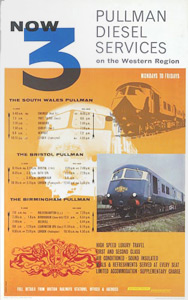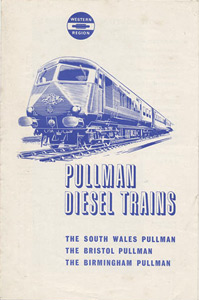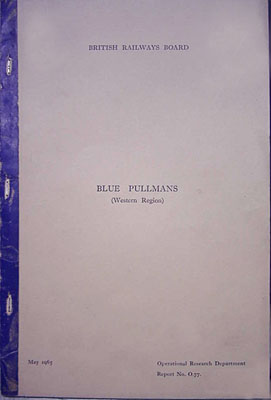Blue Pullman
WR Operations

From the summer 1961 timetable there was an additional service which reached Swansea. The "South Wales Pullman" also called at Cardiff and then all major stations till Swansea.

| Paddington | 08:50 |
| Cardiff | 11:40 |
| Swansea High Street | 13:10 |
A larger version on the colour poster can be viewed on Getty Images. On the right is the cover of a timetable for the three services.
There was a spare steam set kept at Old Oak common to cover breakdowns and maintenance of the Pullmans, this was formed of cars 27, 249, 169, 54, Cecelia and standard FOs W3093/4; all in Pullman Umber & Cream livery. Yet fast turnaround times at Paddington didn't always allow this set to be sprung into action, an example being on the 1st December 1961 when traction motor trouble saw a Castle steam loco use stock of the 09:38 ex-Hanley-in-Arden on the Birmingham Pullman. The week before five cars were noted on the Oxford, Worcester and Wolverhampton line running via Stourbridge, Worcester and Cheltenham for attention at Swindon.
On 22 February 1962 Dr Richard Beeching took a cab ride on a South Wales Pullman, images of this can be found on Getty Images: one; two; and three.
From the winter '62 timetable there were some changes to the standby set, the 2 FOs were removed, Pullman kitchen first cars AURELIA, CECILIA, CHLORIA, MEDUSA and ROSAMUND were returned to the Southern Region, and four second class Pullman cars are converted to first class and allocated names;
Parlour – WYE (ex-CAR No.35);
Parlour – AVON ( ex-CAR No.66);
Kitchen – THAMES (ex-CAR No.61); and
Kitchen - SEVERN – (ex-CAR No.60).
A seven-car WR set was known to have worked on the South Wales Pullman, it being short of a Parlour First (an undated photo of this shows it in original livery).
Each set was scheduled a 7-week overhaul every 3 years. Stocks of spares were kept low - their limited numbers meant less demand and higher prices for these. It did result in some problems at times, such as after a spate of fatigue failures in bogie frames.
In 1962, another British Transport film was made using the Blue Pullman. "Let's Go To Birmingham" was a drivers eye view of a run from Paddington to Birmingham Snow Hill. The driver, Ernest Morris was one of the first to have been passed on the sets. Sadly on the 15th August 1963 he was fatally injured when operating the southbound Birmingham Pullman - an occasion when the Blue Pullman had been replaced by a Western diesel hydraulic locomotive and nine Pullman carriages - when it struck a freight train in Knowle & Dorridge station.
The 1964 passenger figures for each service was:
South Wales Pullman - 104,000
Bristol Pullman - 134,000
Birmingham Pullman - 157,000
At the time each set had an annual cost associated of £75,000, working out at .207/per train mile which was favourable compared with a loco-hauled set at .208/per train mile. This included maintenance costs were quoted at £35,000 p.a., a figure that was higher than most trains due to the travelling technicians and standby train. These figures showed that they were profitable, the average fare receipt per passenger being 35/-.

After the LMR services ended the WR received the two 6-car sets, and for the same reason that the LMR service was withdrawn (a better electric service from Euston), the Birmingham & Wolverhampton services were withdrawn in March 1967. In anticipation of this, the Operations Research Department was asked to look at the options available to the WR in using the 36 vehicles. The report (no. O77 dated May 1965) concluded that "From this general survey of the problem it is not obvious that the Western Region can make profitable use of all the 36 existing Blue Pullman cars." It did mention that the only additional service that they might be able to operate would be taking over "The Golden Hind" on the South West route, with a fill in turn from Paddington to Oxford. It also thought there could be potential in reciprocal trains on the Bristol and South Wales trains but with a danger of going beyond the "saturation point" for Pullmans on these routes.
It also examined eight different possible formations for the 36 cars and possible conversions.
In the end when the LMR cars did arrive there was a new non-stop Oxford service which covered the 63 1/2 miles in one hour, starting on the 6th March 1967. They were also used on additional Bristol trains which stopped at Bath. The "Bristol Pullman" made use of both 6-car sets on the 08:45 from Bristol and 17:45 return. Finally, there was a new 09:00 service from Paddington to Swansea, the return leaving at 16:20.
When the LMR cars were transferred to the WR, it was felt that there was not enough capacity in a 6-car set. The two units passed through Swindon Works to receive modifications to the bottom of the cab end to give unhindered access to the coupling/drawhook. Multiple working jumpers were fitted, just below the windowscreens on the far sides. After conversion they emerged in their original livery with a yellow panel added on the cabs, and the "Midland" on the power cars sides ommited. None of the WR sets were converted.
Occasionally their regular workings saw diversions due to engineering work, for example the South Wales Pullman is known to have worked along the Vale of Glamorgan line, also the ex-Taff Vale mainline through the Taff & Rhondda valleys and on to Swansea via the Rrondda an Swansea Bay line on an occasion when the Cardiff Swansea mainline was blocked beyond the junction of the Vale of Glamorgan line.
Last Birmingham Pullman
The last Birmingham Pullman ran on Friday March 3 1967. The occassion was marked on the last down service by the catering staff making two huge iced cakes, topped with the Pullman insignia and the text "Birmingham Pullman 500,000 miles", being the estimated mileage since inrtoduction. The WR and LMR "Miss Rail News" girls distributed pieces to the 210 passengers. For the driver it was his last duty before retiring, Mr R. Cox of Stafford Road had been a regular at the controls since the service began in 1961.
On Saturday March 4 1967 the set at Birmingham was used on a West Bromwich to Wembley football special, after returning in the evening it ran empty to Old Oak Common ready to start the following week on services to Swansea and Oxford.
The Birmingham Pullman service was replaced by a 07:50 New Street - Euston loco-hauled service named "The Executive" which made the journey 30 minutes faster.[1]
After the end of the Birmingham Pullman, the revised diagrams required four of the five sets in service daily, leaving one set spare -
Set 1 (eight-car): Swansea - Paddington - Cardiff - Paddington - Swansea
Set 2 (eight-car): Paddington - Swansea - Paddington
Sets 3 & 4 (two six-cars): Bristol - Paddington, divide, one Paddington - Bristol return, other Paddington - Oxford return, combine for Paddington - Bristol.[2]
The Bristol Pullman changed from a 12-car working to a 8-car working on the 4th October 1971.
Excursions
As their regular diagrams were Mondays-Fridays this left them free at weekends for maintenance but it also allowed use on a few excursions and charters. Some of these workings include a WR set running to West Hartlepool from Coventry in the 13th March 1965 in connection with a Rugby Union Championship Final (Durham v. Warwickshire) led by W60097, and a trip from Swansea to Aintree for the Grand National Day on 21st March 1964[3].
Other examples: as part of an transport study course a WR set worked an educational tour from Surbiton to South Wales on 25th April 1970. Also in 1970 on the 15th August there was a Paddington - Newbury Racecourse Special taking them over the Berks & Hants line. Former LMR set 60090 / 60730 / 60740 / 60741 / 60731 / 60091 worked from London to Plymouth on Christmas Eve 1970. It returned empty to Bristol, being piloted over the banks between Plymouth and Exeter by Western D1054. It was back in Plymouth a few days later on the 28th to work the return to London (Kensington), this time piloted as far as Exeter. Organised by Ian Allan, in 1971 a WR set worked Paddington to Brockenhurst on the 25th March in connection with an evening package tour that included a banquet at Beaulieu Abbey. Another visit to the Southern Region's SW Division was on a Surbiton to Carmarthen railtour in the 25th April 1970.
References
- ⋏ June 1967, p211 Railway Observer
- ⋏ June 1967, p203 Railway Observer
- ⋏ April 1964, p137 Railway Observer
The Railway Observer is the journal of the Railway Correspondence and Travel Society
Summary
Development
Press run 24/6/60
Press run 7/9/60
Staff difficulties
Ownership agreement
Manufacturer's Publicity
Description
Type 1 - LMR motor car
Type 2 - WR motor car
Type 3 - WR parlour 2nd car
Type 4 - LMR kitchen car
Type 5 - WR kitchen car
Type 6 - LMR/WR parlour 1st car
Interior
Air conditioning
Motor cars
Auxiliary power
Bogies & couplings
Brakes
Data
Sub contractors
Staff instructions
LMR services begin
LMR Publicity
LMR brochure
LMR handbills
Controversy
WR services begin
WR publicity
WR publicity brochure
WR publicity leaflet
LMR Operations
WR Operations
Liveries
Rundown & withdrawal
After service & preservation
Disposal
Maintenance Manuals
Miscellaneous
Acknowledgments & Further Reading
Images
No vehicles were preserved.


